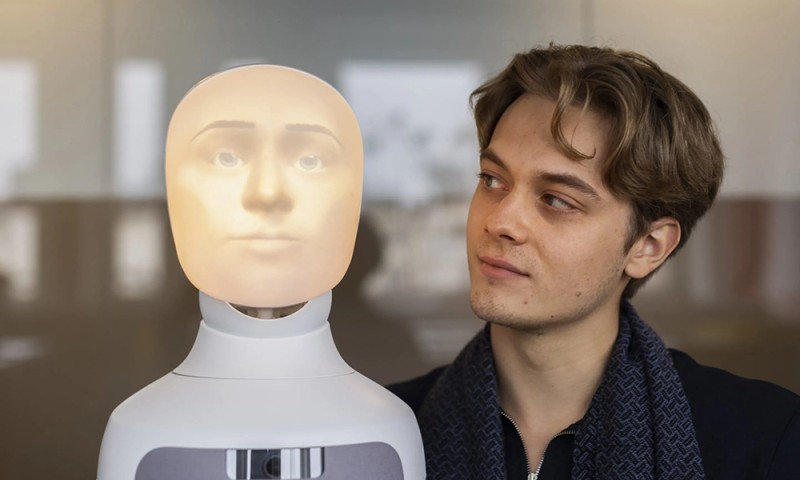
六个月前,我们积极布局机器人领域,主动发掘投资机会——然而彼时每月仅收到寥寥数份项目计划书。如今,这一数字已大幅飙升。短短半年间,我们接触的机器人企业已覆盖全产业链:从机器人基础模型开发者,到全栈机器人制造商、人形机器人研发者,乃至为这些技术提供支持的工具类企业。
机器人行业正蓬勃发展,仅2024年一年,风险投资机构就向机器人企业投入超70亿美元资金。多家企业的巨额融资轮次——如Figure(B轮融资6.75亿美元)、Physical Intelligence(A轮融资4亿美元)、Skild(A轮融资3亿美元)——标志着投资者对机器人领域的兴趣大幅增加。据预测,全球机器人市场将呈指数级增长:到2034年,仅工业机器人市场规模就有望达到约600亿美元;到2029年,服务机器人市场规模预计将增至约990亿美元。
当下的机遇
尽管机器人技术正迅速成为人工智能领域中最具活力、发展最为迅猛的类别之一,但它也是技术复杂度最高、学习曲线最陡峭的领域之一——尤其是对于评估新企业的投资者而言。与大型语言模型(LLM)不同(此类模型有标准化基准可提供清晰的性能指标),机器人技术尚未建立普遍认可的跨公司能力比较框架。这种复杂性源于该领域的独特定位:它处于人工智能、硬件设计与工程、供应链、制造业以及实际场景部署的交叉点——要打造一家成功的机器人公司,上述每个环节都需要不同领域的专业知识支撑;而投资者在评估企业时,也需采用一套截然不同的评判标准。简而言之,将人工智能引入物理世界,比将其引入数字世界更具挑战性。
作为投资者,我们力求尽早介入——不仅是为了支持有潜力的企业,更是为了在这一技术的发展过程中发挥建设性作用。机器人技术已不再是科幻小说中的情节,它正迅速成为现实,并将重塑人类的生活、工作与开发方式。
随着人工智能开始重塑物理世界,我们正见证技术进步与重大机遇的罕见交汇。从仓储自动化到通用型机器人形态,这些系统不仅能执行任务,还能在实际环境中学习、适应并持续优化。打造这些技术的企业,正在为构建更高效、更具韧性的未来奠定基础——若能以审慎的方式推进发展,还将在提升工作效率的同时,确保人类始终扮演不可替代的关键角色。
为助力探索该领域的同行,我们近期整理了一份关于市场机遇、机器人投资的独特挑战以及企业评估框架的入门指南。鉴于指南内容较为深入,在此我们先概述评估机器人初创企业的三大核心要点:
1. 寻求跨学科优势与前瞻性领导力。
机器人技术绝非单纯的人工智能课题——它是软件、硬件、数据、制造与运营的融合。成功企业需在早期汇聚各领域的顶尖人才,但仅有“精英背景”远远不够。我们寻找具备第一性原理思维,能基于现代技术架构开展研发,且拥有与行业未来发展方向相契合的长期愿景的团队——而非固守过往成就。
2. 切勿轻信演示——深入探究其本质
若想真正评估机器人的能力,关键在于理解演示背后的场景。该系统是完全自主运行,还是存在一定程度的远程操控?物体或环境是否经过布置以简化任务?只要有机会,就应实地观察系统运行状况:在非受控环境中(尤其是当流程未能按照预期推进时)的表现,往往比精心准备的演示更具参考价值。必要时,可适当打断机器人的工作流程,观察其应对方式。
3. 评估实际表现,而非仅看潜力
由于缺乏通用评估标准,投资者需依据企业自身的“成功定义”进行判断。需追问可量化的指标,例如任务成功率、吞吐量、自主运行时长等。了解部署周期、所需培训内容,以及数据策略能否形成持续改进的反馈循环。归根结底,最具潜力的机器人初创企业,既能展现雄厚的技术实力,又拥有可扩展的部署模型,还能为客户提供清晰的投资回报率蓝图。这是从上一轮机器人热潮中汲取的经验教训之一——避免陷入概念验证困境。
未来发展路径
随着人工智能驱动的机器人初创企业日趋成熟,风投机构需从过往周期中汲取经验教训。2014—2015年,许多机器人公司陷入困境,它们仅能为单个客户提供一次性集成服务,缺乏广泛应用与规模化发展的清晰路径。当前机器人企业受益于硬件效率的飞跃性提升、可扩展的数据采集方法以及以往周期中未曾具备的人工智能能力。这些领域的技术进步相互融合,使机器人技术终于有望走向主流。
随着数字人工智能的迅猛发展,物理世界成为下一个至关重要的自动化前沿领域。当人工智能模型在软件工程、客户支持及数据分析等领域增强白领工作者能力时,针对体力劳动的自动化解决方案仍有巨大挖掘空间。在软件领域,人工智能正推动开发民主化,技术护城河正逐渐消弭;而在机器人领域,由于物理世界集成的复杂性,其技术护城河依然稳固。
其价值并非实现劳动自动化,而是构建能增强人类能力、在实际部署中持续学习和优化的系统。这类企业具备长期发展的战略潜力,且技术门槛高:随着时间推移,其积累的“数据复利优势”及与物理环境的深度融合,将形成纯软件模式难以复制的竞争护城河。
愿意审慎评估这些跨领域企业的投资者,将成为助力构建并重塑未来物理世界的关键力量。(*)
作者Emily Zhao是Salesforce Venture负责人,Pascha Hao是Salesforce Venture投资人)
Fortune.com上发表的评论文章中表达的观点,仅代表作者本人的观点,不代表《财富》杂志的观点和立场。
译者:中慧言-王芳
六个月前,我们积极布局机器人领域,主动发掘投资机会——然而彼时每月仅收到寥寥数份项目计划书。如今,这一数字已大幅飙升。短短半年间,我们接触的机器人企业已覆盖全产业链:从机器人基础模型开发者,到全栈机器人制造商、人形机器人研发者,乃至为这些技术提供支持的工具类企业。
机器人行业正蓬勃发展,仅2024年一年,风险投资机构就向机器人企业投入超70亿美元资金。多家企业的巨额融资轮次——如Figure(B轮融资6.75亿美元)、Physical Intelligence(A轮融资4亿美元)、Skild(A轮融资3亿美元)——标志着投资者对机器人领域的兴趣大幅增加。据预测,全球机器人市场将呈指数级增长:到2034年,仅工业机器人市场规模就有望达到约600亿美元;到2029年,服务机器人市场规模预计将增至约990亿美元。
当下的机遇
尽管机器人技术正迅速成为人工智能领域中最具活力、发展最为迅猛的类别之一,但它也是技术复杂度最高、学习曲线最陡峭的领域之一——尤其是对于评估新企业的投资者而言。与大型语言模型(LLM)不同(此类模型有标准化基准可提供清晰的性能指标),机器人技术尚未建立普遍认可的跨公司能力比较框架。这种复杂性源于该领域的独特定位:它处于人工智能、硬件设计与工程、供应链、制造业以及实际场景部署的交叉点——要打造一家成功的机器人公司,上述每个环节都需要不同领域的专业知识支撑;而投资者在评估企业时,也需采用一套截然不同的评判标准。简而言之,将人工智能引入物理世界,比将其引入数字世界更具挑战性。
作为投资者,我们力求尽早介入——不仅是为了支持有潜力的企业,更是为了在这一技术的发展过程中发挥建设性作用。机器人技术已不再是科幻小说中的情节,它正迅速成为现实,并将重塑人类的生活、工作与开发方式。
随着人工智能开始重塑物理世界,我们正见证技术进步与重大机遇的罕见交汇。从仓储自动化到通用型机器人形态,这些系统不仅能执行任务,还能在实际环境中学习、适应并持续优化。打造这些技术的企业,正在为构建更高效、更具韧性的未来奠定基础——若能以审慎的方式推进发展,还将在提升工作效率的同时,确保人类始终扮演不可替代的关键角色。
为助力探索该领域的同行,我们近期整理了一份关于市场机遇、机器人投资的独特挑战以及企业评估框架的入门指南。鉴于指南内容较为深入,在此我们先概述评估机器人初创企业的三大核心要点:
1. 寻求跨学科优势与前瞻性领导力。
机器人技术绝非单纯的人工智能课题——它是软件、硬件、数据、制造与运营的融合。成功企业需在早期汇聚各领域的顶尖人才,但仅有“精英背景”远远不够。我们寻找具备第一性原理思维,能基于现代技术架构开展研发,且拥有与行业未来发展方向相契合的长期愿景的团队——而非固守过往成就。
2. 切勿轻信演示——深入探究其本质
若想真正评估机器人的能力,关键在于理解演示背后的场景。该系统是完全自主运行,还是存在一定程度的远程操控?物体或环境是否经过布置以简化任务?只要有机会,就应实地观察系统运行状况:在非受控环境中(尤其是当流程未能按照预期推进时)的表现,往往比精心准备的演示更具参考价值。必要时,可适当打断机器人的工作流程,观察其应对方式。
3. 评估实际表现,而非仅看潜力
由于缺乏通用评估标准,投资者需依据企业自身的“成功定义”进行判断。需追问可量化的指标,例如任务成功率、吞吐量、自主运行时长等。了解部署周期、所需培训内容,以及数据策略能否形成持续改进的反馈循环。归根结底,最具潜力的机器人初创企业,既能展现雄厚的技术实力,又拥有可扩展的部署模型,还能为客户提供清晰的投资回报率蓝图。这是从上一轮机器人热潮中汲取的经验教训之一——避免陷入概念验证困境。
未来发展路径
随着人工智能驱动的机器人初创企业日趋成熟,风投机构需从过往周期中汲取经验教训。2014—2015年,许多机器人公司陷入困境,它们仅能为单个客户提供一次性集成服务,缺乏广泛应用与规模化发展的清晰路径。当前机器人企业受益于硬件效率的飞跃性提升、可扩展的数据采集方法以及以往周期中未曾具备的人工智能能力。这些领域的技术进步相互融合,使机器人技术终于有望走向主流。
随着数字人工智能的迅猛发展,物理世界成为下一个至关重要的自动化前沿领域。当人工智能模型在软件工程、客户支持及数据分析等领域增强白领工作者能力时,针对体力劳动的自动化解决方案仍有巨大挖掘空间。在软件领域,人工智能正推动开发民主化,技术护城河正逐渐消弭;而在机器人领域,由于物理世界集成的复杂性,其技术护城河依然稳固。
其价值并非实现劳动自动化,而是构建能增强人类能力、在实际部署中持续学习和优化的系统。这类企业具备长期发展的战略潜力,且技术门槛高:随着时间推移,其积累的“数据复利优势”及与物理环境的深度融合,将形成纯软件模式难以复制的竞争护城河。
愿意审慎评估这些跨领域企业的投资者,将成为助力构建并重塑未来物理世界的关键力量。(*)
作者Emily Zhao是Salesforce Venture负责人,Pascha Hao是Salesforce Venture投资人)
Fortune.com上发表的评论文章中表达的观点,仅代表作者本人的观点,不代表《财富》杂志的观点和立场。
译者:中慧言-王芳
Six months ago, we were leaning into the robotics space, proactively sourcing opportunities — but still only seeing a few inbound pitches a month. Today, that number has skyrocketed. In just half a year, we’ve met with robotics companies spanning the gamut – from those building robotics foundation models (RFMs) to full-stack robots, humanoids, and the tooling that powers them.
The industry is booming, with venture capitalists pouring over $7 billion into robotics companies in 2024 alone. Mega-rounds in companies like Figure ($675M Series B), Physical Intelligence ($400M Series A), and Skild ($300M Series A) signal a major surge in investor appetite for robotics. The global robotics market is forecasted to grow exponentially, with industrial robotics alone projected to reach around $60 billion by 2034 and service robotics expected to grow to about $99 billion by 2029.
The opportunity at hand
While robotics is quickly becoming one of the most dynamic and fast-moving categories in AI, it’s also one of the most technically complex, with a steep learning curve – particularly for investors evaluating new players. Unlike LLMs — where standardized benchmarks provide clear performance metrics — robotics does not have a universally accepted framework for comparing capabilities across companies. This complexity stems from the field’s unique position at the crossroads of AI, hardware design and engineering, supply chain, manufacturing, and real-world deployment – all of which require different expertise to build towards a successful company, as well as a different set of criteria for investors to assess. In short, bringing AI to the physical world is harder than bringing AI to the digital world.
As investors, we aim to engage early — not only to support promising businesses, but to play a constructive role in how this technology develops. Robotics is no longer science fiction; it’s a rapidly unfolding reality with the potential to transform how we live, work, and build.
As AI begins to shape the physical world, we see a rare convergence of technological progress and meaningful opportunity. From warehouse automation to generalist robotic form factors, these systems don’t just execute tasks — they can learn, adapt, and improve in real-world environments. The companies building them are laying the groundwork for a future that’s more efficient and more resilient — and, if developed thoughtfully, one that augments work without losing the critical role people play.
To support others exploring this space, we recently put together a primer on the market opportunity, the unique challenges of investing in robotics, and our framework for evaluating companies in the category. It’s a deep dive, so we’ve outlined our top three takeaways for evaluating robotics startups here:
1. Look for interdisciplinary excellence and future-facing leadership.
Robotics isn’t just an AI problem — it’s a convergence of software, hardware, data, manufacturing, and operations. Winning companies need top-tier talent across each of these disciplines early, but pedigree isn’t enough. We look for teams who operate with first-principles thinking, build on modern technical architectures, and have a long-term vision aligned with where the industry is headed — not where it’s been.
2. Don’t trust the demo — interrogate it.
To truly gauge a robot’s capabilities, it’s important to understand the context behind the demo. Is the system operating fully autonomously or with some degree of teleoperation? Are the objects or environments arranged to simplify the task? Whenever possible, observe the system in person. Performance in uncontrolled environments — especially when things don’t go exactly as planned — is often a more useful signal than a polished demo. If appropriate, gently interrupt the robot’s workflow to see how it responds.
3. Evaluate real-world performance, not just potential.
With no universal benchmarks, investors must rely on a company’s own definitions of success. Ask about measurable metrics like task success rates, throughput, and autonomy duration. Understand how long deployments take, what training is required, and whether the data strategy creates a feedback loop for continual improvement. Ultimately, the most promising robotics startups pair technical depth with scalable deployment models and a clear ROI narrative for customers. This is one of the learnings from the last wave of robotics – being stuck in POC purgatory.
The path forward
As the AI generation of robotics startups matures, VCs need to learn from previous cycles. Many robotics companies from the 2014-2015 era got trapped performing one-off integrations for each customer without clear paths to broader implementation and scale. Current robotics companies benefit from dramatically improved hardware efficiency, scalable data collection methods, and AI capabilities that weren’t available in previous cycles. The convergence of progress in these areas puts robotics in a position to finally go mainstream.
As digital AI advances rapidly, the physical world represents the next major automation frontier. While AI models augment white-collar workers across software engineering, customer support, and data analysis, physical labor solutions remain largely untapped. Technical moats that are eroding in software, where AI democratizes development, remain strong in robotics due to the complexity of physical world integration.
The promise isn’t about automating labor, but about building systems that augment human capabilities and continuously learn and improve through real-world deployment. These are long-arc, highly technical businesses — and over time, their compounding data advantage and deep integration with physical environments create competitive moats that purely software-based models will find increasingly difficult to replicate.
Investors willing to thoughtfully evaluate these multidisciplinary companies will be the ones helping build and transform the physical world for our future.

